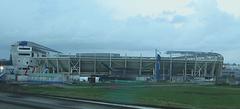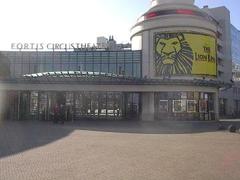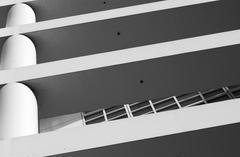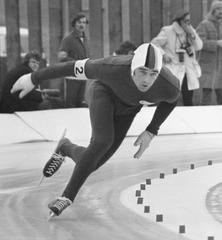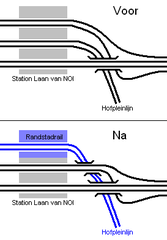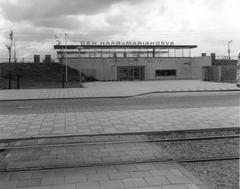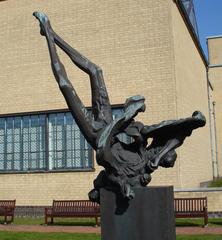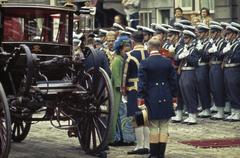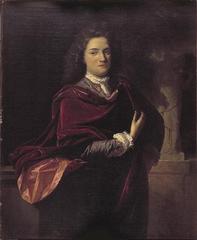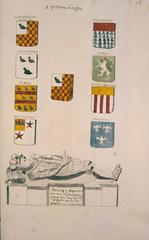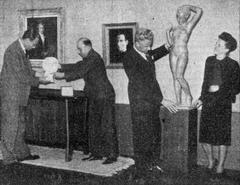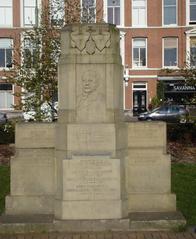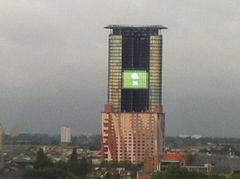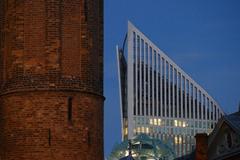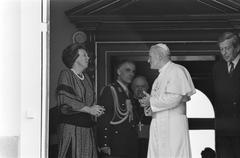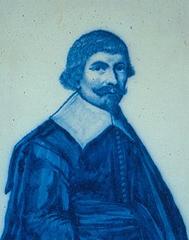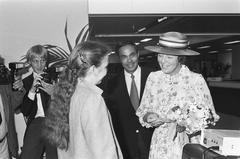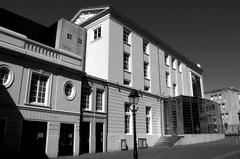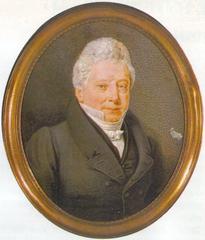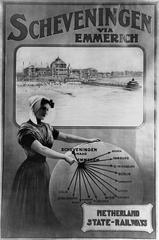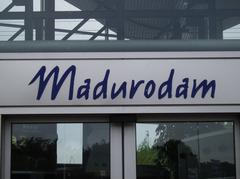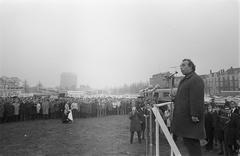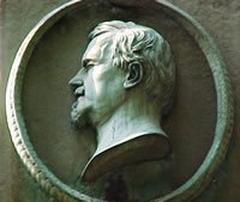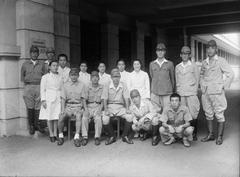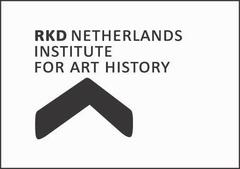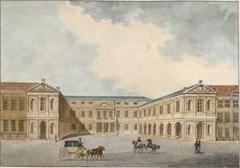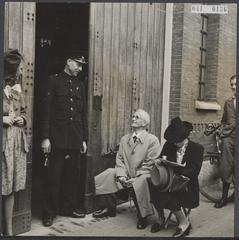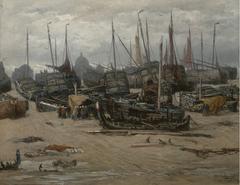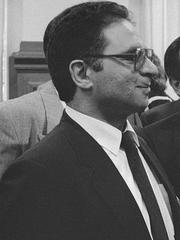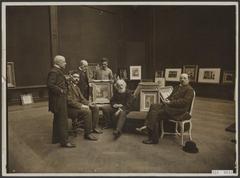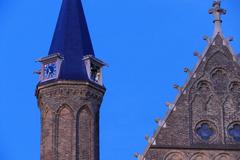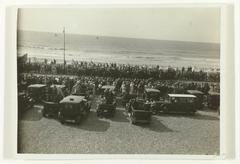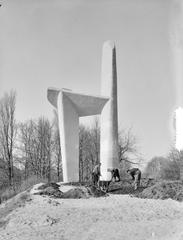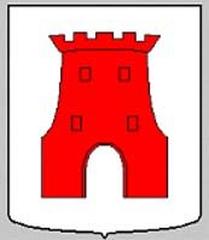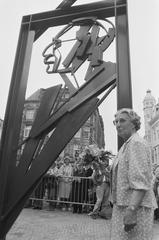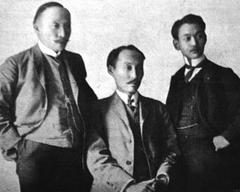
Castalia Visiting Hours, Tickets, and Guide to Historical Sites in The Hague
Date: 04/07/2025
Introduction to Castalia in The Hague
Nestled in the heart of The Hague’s governmental district, Castalia stands as a striking testament to the city’s architectural evolution and civic identity. Completed in 1998, this iconic twin-tower complex was designed by renowned American architect Michael Graves in collaboration with Dutch architect Sjoerd Soeters, harmoniously blending Dutch canal house motifs with bold postmodern elements (Skyscraper Center; Dexigner). At 104 meters tall with 20 floors, Castalia is not only one of The Hague’s tallest buildings but also a central hub for the Ministry of Health, Welfare and Sport (VWS), reflecting the city’s administrative significance.
This comprehensive guide explores Castalia’s history, architectural significance, visitor access, and its integration into The Hague’s urban and cultural landscape. It also offers practical information on visiting hours, ticketing, accessibility, and recommendations for nearby historical sites such as the Binnenhof and Mauritshuis Museum (OrangeSmile Architecture Guide; The Hague Historical Sites). Whether you are an architecture enthusiast, history buff, or a curious traveler, this resource equips you to fully appreciate Castalia’s unique place in Dutch architecture and governance.
Table of Contents
- Introduction
- Historical Context and Transformation
- Architectural Significance
- Visitor Information
- Nearby Attractions
- Public Perception and Social Impact
- Frequently Asked Questions (FAQ)
- Conclusion and Visitor Tips
- References
Historical Context and Transformation
Castalia originated as the 19-story Transitorium office tower built in the 1950s. During the 1990s, a period marked by significant urban renewal, the building underwent a dramatic transformation under Michael Graves and Sjoerd Soeters. Retaining the original steel skeleton, they introduced new brick facades and the now-iconic gabled rooflines, illustrating Dutch urbanism’s preference for adaptive reuse over demolition (Michael Graves Architecture & Design; Dexigner).
The redevelopment was part of the De Resident urban renewal project, positioned at the heart of The Hague’s administrative district near Central Station. Today, Castalia houses the Ministry of Health, Welfare and Sport, while its twin, Helicon, serves the Ministry of Social Affairs and Employment. The complex is connected by a transparent, light-filled atrium designed by cepezed, serving as a vibrant public hub (Cepezed).
Architectural Significance
Design and Symbolism
Castalia’s design is immediately recognizable by its twin pointed, red-tiled gables—a monumental reinterpretation of traditional Dutch canal houses (OrangeSmile Architecture Guide). The brick facades, white-trimmed windows, and rhythmic gable forms pay homage to the Netherlands’ architectural heritage while embracing contemporary postmodern sensibilities. The ground floor atrium, designed by cepezed, connects Castalia and Helicon, creating a welcoming, transparent public space.
Engineering and Urban Integration
Structural engineering by Ingenieursbureau Grabowsky & Poort enabled large, flexible office spaces within the towers while maintaining Graves’ bold vision. The building’s massing and orientation were carefully chosen to complement the surrounding historic and governmental landmarks, including close proximity to the Binnenhof and the Ministry of Justice. The façade’s interplay of brick and glass is particularly striking in changing light, further enhancing Castalia’s visual impact (OrangeSmile Architecture Guide).
Inside, HofmanDujardin’s design pays tribute to Dutch artistic heritage, integrating motifs inspired by Berlage, Vermeer, and De Hooch. Notably, each floor features unique floor tiles based on Dutch masterpieces, creating a culturally rich environment (Dexigner).
Visitor Information
Visiting Hours and Access
- Public Areas: The ground floor atrium and café are open to visitors Monday through Friday from 8:00 AM to 6:00 PM. No tickets or appointment are required for these spaces.
- Office Spaces: Access beyond the public atrium and café is restricted to ministry staff and authorized guests.
- Special Events: Guided tours are occasionally offered during open house events or national occasions. Check the Ministry of Health, Welfare and Sport’s website for updates.
Tickets and Tours
- Tickets: There is no fee to visit Castalia’s public areas.
- Guided Tours: Available only during special events or by appointment. Advance registration may be required.
Accessibility
Castalia is fully accessible, in line with The Hague’s commitment to inclusivity (DenHaag.com; Journeyable):
- Step-free entrances and ramps
- Multiple elevators serving all floors
- Accessible restrooms on public levels
- Clear wayfinding signage
- Proximity to accessible public transport
For specific needs, contact the building’s reception in advance to arrange assistance.
Photography and Visitor Tips
- Photography: Permitted in public areas. Avoid photographing security personnel or sensitive areas.
- Security: Bring valid photo ID and allow time for entry screening.
- Best Times: Early morning or late afternoon for optimal lighting and fewer crowds.
- Transport: Castalia is a short walk from Den Haag Centraal station, accessible by tram, train, and bus.
Nearby Attractions
Castalia’s central location makes it an ideal starting point to explore The Hague’s landmarks:
- Binnenhof: The historic seat of Dutch parliament, renowned for its gothic halls and courtyards (DutchReview).
- Mauritshuis: A world-class museum with Dutch Golden Age masterpieces, fully accessible to visitors.
- Escher in Het Paleis: Interactive museum dedicated to M.C. Escher, housed in a former royal palace.
- Peace Palace: Home to the International Court of Justice, with accessible visitor center and gardens.
- Scheveningen Beach: Accessible beach paths, lively pier, and beach wheelchairs available (DestinationAbroad).
- Clingendael Park: Expansive gardens, canals, and the seasonal Japanese Garden, all wheelchair accessible.
Public Perception and Social Impact
Local Identity and Nicknames
Castalia’s twin gabled roofs have earned it the local nickname “Haagse Tieten” (“Hague’s Tits”) (Pin-Up Magazine). This playful moniker reflects both affection and debate over the building’s postmodern style. Initially divisive, Castalia has since gained landmark status and is recognized as a Dutch national monument, reflecting The Hague’s evolving identity (Michael Graves Architecture & Design).
Community Engagement
The open atrium and café encourage interaction between government staff and the public, embodying Dutch values of transparency (Cepezed). The building’s proximity to Central Station and integration with De Resident has revitalized its urban neighborhood.
Frequently Asked Questions (FAQ)
Is Castalia open to the public?
Yes, the ground floor atrium and café are open to visitors Monday–Friday, 8:00 AM–6:00 PM.
Are guided tours available?
Guided tours are offered during special open house events or by appointment. Check official websites for details.
Is there an entry fee?
No, visiting the public atrium and café is free.
Is Castalia accessible for people with disabilities?
Yes, with step-free access, elevators, and accessible restrooms.
Can I take photographs inside Castalia?
Photography is permitted in public areas, but may be restricted in office zones or during official events.
How do I get to Castalia by public transport?
Castalia is a short walk from Den Haag Centraal station and well served by trams and buses.
What nearby attractions should I visit?
Binnenhof, Mauritshuis, Peace Palace, and Escher in Het Paleis are all nearby and highly recommended.
Conclusion and Visitor Tips
Castalia is a vibrant example of how modernization and heritage can coexist, symbolizing The Hague’s ongoing evolution as a center for culture, governance, and architectural innovation. While interior access is limited due to its governmental function, the public atrium and café offer a window into the building’s unique design and atmosphere. Don’t miss the opportunity to explore the surrounding plazas, capture the iconic gabled roofs at sunrise or sunset, and combine your visit with nearby historical sites (Dexigner; OrangeSmile Architecture Guide).
For updates on opening hours, special events, or accessibility, check official channels and consider downloading the Audiala app for real-time information and guided tours. Castalia stands as a testament to thoughtful urban renewal, inviting visitors to experience The Hague’s architectural narrative and civic pride.
References and Further Reading
- Skyscraper Center – Castalia
- Dexigner – Castalia Visiting Hours, Tickets, Accessibility, and Nearby Historical Sites in The Hague
- OrangeSmile Architecture Guide – The Hague
- The Hague Historical Sites
- Michael Graves Architecture & Design – Castalia
- DenHaag.com – Accessibility
- Journeyable – Accessible Travel in The Hague
- DutchReview – Free Things to Do in The Hague
- DestinationAbroad – Is The Hague Worth Visiting?
- Cepezed – De Resident
- Pin-Up Magazine – Michael Graves Top Ten
- Office Snapshots – Ministry VWS/SZW Offices
- Arqa – De Resident in The Hague
- Academia.edu – Postmodern Historicism at Castalia








